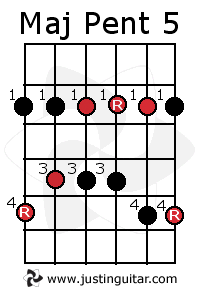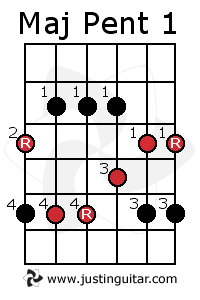The scale we're about to learn is used loads in country, blues and rock. It's a little strange to get used to at first, because the patterns are the same as for the Minor Pentatonic, but the root note is different!! huh?
Please note that this is Pattern 5! As an Minor Pentatonic it is Pattern 1 - but now the root note has changed, the chord tones are different and you have to use it a different way!

You remember all about root notes right? So you know to place the root here at the 5th fret to be playing the A Major Pentatonic Scale.
The red notes are the chord tones for the Major chord - they are the notes that will sound cool to stop on.
YOU CAN'T JUST PLAY THE MINOR PENATONIC LICKS!
You really have to treat this as a new scale to start with - sure there are some minor pentatonic licks you can sneak in there later, but much better to start with thinking of it as a whole new thing!
We should really check out Pattern 1 as well...

It's always a good idea to learn Pattern 1 of a scale, and so now that you are not going to get confused by the similarity of the shapes, we're going to check out The Major Pentatonic Pattern 1.
This one is really commonly used by country guys and the early blues players like Chuck Berry. Later on you can mix it up with the Minor Pentatonic to great effect too!
The more observant of you might notice that some of the extra notes are similar to those we used in our Blues Hybrid Scale ;)
Good fun playing with this one (it's the same as Pattern 2 of the Minor Pentatonic, but we've not checked that out yet!).
By far the best (only?) way to practice this stuff is to use them! Either with a jam buddy, recording yourself and playing over it or a Backing Track or I suppose the best would be jamming with a full band if you have the luxury!
Try this C Major Chilli Funk backing track
Put on the backing track and solo for the full 5 minutes and just experiment. listen to each of the notes and how it affects the backing track. You will find with this scale that some notes sound awesome over some chords and sound pretty crummy over others.
The most important of these notes to check out is the note C Sharp (in pattern one it is the note on the third string in the sixth fret). This note will sound great over the A or A7 chord but will sound really bad over the D7 chord. this is because of a clash of notes. The D7 cord contains the note C, so the C Sharp really clashes with it, and not in a cool way. So one of the things that you need to check out is what notes sound cool over what chords - and you do that by listening. This just takes practice, you just learn to avoid the notes that don't sound cool over particular chords.
A great thing to do is play a minor pentatonic lick - then move it down 3 frets (it will be then the major pentatonic, and listen to the difference!! You will often find that you can use a minor pentatonic lick but you just have to adapt it a little, maybe starting or finishing on a different note.
But as I said, you can't be doing that all the time - you must learn to use this scale like it's completely new!
When you have it memorised we're going to move onto looking at playing scales with a Legato Technique!